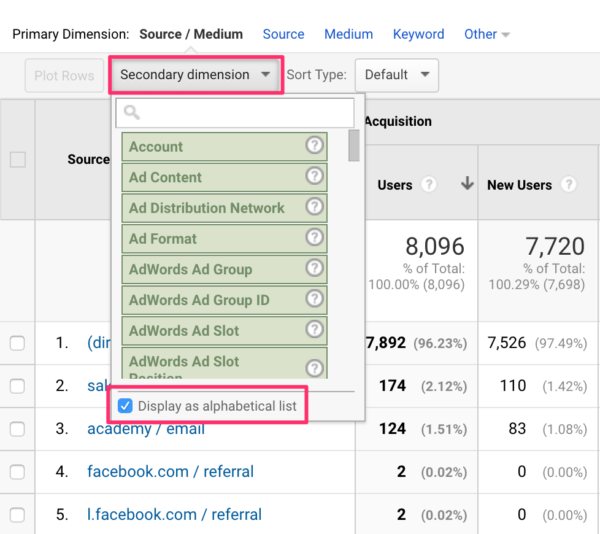Revealing the Intricacies of Second Measurement in Google Analytics: a Comprehensive Overview on Exactly How It Functions
Browsing the detailed world of additional dimensions in Google Analytics is a job that needs an eager understanding of exactly how this feature operates within the platform. As electronic landscapes advance and information becomes increasingly essential for decision-making, understanding the subtleties of additional measurements can be the trick to unlocking useful understandings. From setting up records to diving into innovative strategies, the journey to harnessing the power of additional dimensions is both difficult and gratifying. Join us as we check out the complexities of this tool and find how it can reinvent your information analysis strategies.
Essentials of Additional Measurement in Google Analytics
When analyzing data in Google Analytics, using the secondary measurement function gives beneficial understandings right into the performance of numerous metrics. The additional dimension allows individuals to further dissect their information by including an extra layer of information to their primary dimensions. By doing so, analysts can get a much more comprehensive understanding of the elements influencing their website's efficiency.
In Google Analytics, the key measurements stand for the major categories of information, such as web traffic sources or tools. When an additional dimension is applied, it supplies a deeper degree of granularity by showing another element of the information within the selected primary dimension. If the primary dimension is 'Web traffic Source,' adding an additional dimension like 'Landing Web page' can reveal which particular web pages are driving website traffic from each source.
This feature is specifically beneficial for identifying patterns, relationships, and patterns that may not be promptly evident when taking a look at the data from a single measurement. By leveraging the additional dimension in Google Analytics, users can discover valuable insights that can educate tactical decisions and optimizations to enhance web site efficiency.
Establishing Up Additional Dimension Records
Broadening on the insights got via the application of additional dimensions in Google Analytics, the process of establishing up secondary measurement reports involves configuring additional layers of data to better improve the depth of analysis. As soon as the key record is chosen, customers can click on the "Additional dimension" tab located above the information visualization location. From there, a drop-down menu will appear, giving a variety of choices to pick the secondary dimension that finest enhances the key data set.
Leveraging Second Dimensions for Insights
Utilizing additional measurements in Google Analytics supplies a strategic technique to extracting nuanced insights for educated decision-making in online organization optimization. By incorporating primary dimensions with second dimensions, organizations can dive much deeper right into their information to discover valuable connections and patterns that may not be quickly apparent. For example, by segmenting internet site web traffic by geographical location (primary dimension) and after that including an additional measurement like gadget group, organizations can recognize if specific regions choose accessing the site by means of mobile or desktop.
Additionally, leveraging second dimensions permits services to acquire a far better understanding of user behavior and choices. As an example, analyzing conversion rates based upon traffic sources (main dimension) together with the second measurement of touchdown pages can disclose which specific pages are most efficient in driving conversions for natural search traffic versus social media traffic. These insights can after that educate advertising and marketing methods and site optimization initiatives to enhance general efficiency and take full advantage of additional hints ROI.
Advanced Techniques for Second Dimensions
To further remove complex insights and boost data-driven decision-making within Google Analytics, carrying out sophisticated methods for utilizing secondary dimensions is crucial in unlocking deeper layers of important information for business optimization. One innovative strategy is making use of custom-made dimensions and metrics, permitting for the tracking of certain user interactions or behaviors that are not caught by default in Google Analytics. By carrying out and specifying custom dimensions, organizations can tailor their monitoring to line up with one-of-a-kind organization objectives and goals.
One more innovative technique entails making use of filters in conjunction with secondary dimensions. Filters make it possible for individuals to improve the data showed in Google Analytics records, offering more targeted and pertinent insights. By applying filters tactically with additional measurements, businesses can segment information more effectively, causing a more clear understanding of user actions and performance metrics.

Optimizing Information Analysis With Secondary Measurements

Moreover, optimizing information analysis with second dimensions entails experimenting with various combinations to recognize patterns and relationships that may not be quickly apparent. This repetitive strategy enables analysts to tweak their coverage and concentrate on one of the most pertinent data points for Look At This their business goals. Eventually, by leveraging secondary dimensions successfully, analysts can boost the precision and performance of their information analysis initiatives in Google Analytics.
Conclusion
Finally, recognizing the complexities of second measurements in Google Analytics is crucial for getting much deeper insights right into site efficiency. By establishing secondary dimension reports, leveraging them for understandings, and making use of advanced strategies, experts can maximize data evaluation and make educated choices. This comprehensive overview has actually supplied an in-depth review of exactly how my site secondary measurements work and their importance in enhancing the analytical capacities of Google Analytics customers.
The secondary dimension permits customers to further study their data by adding an extra layer of details to their key dimensions. When a second dimension is applied, it provides a much deeper level of granularity by revealing another element of the data within the chosen main measurement.Expanding on the understandings gained via the use of second measurements in Google Analytics, the procedure of establishing up second measurement reports entails setting up added layers of data to further enhance the deepness of evaluation. By integrating main measurements with second measurements, services can dig deeper into their information to reveal useful connections and patterns that might not be immediately obvious. One way to maximize data evaluation with secondary dimensions is to incorporate them with main measurements to obtain a much more extensive view of website performance.